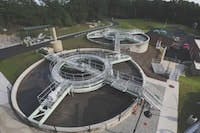Sturbridge, Mass., has historically suffered from periodic blooms of filamentous bacteria that have caused bulking in the secondary clarifiers of their three activated sludge package plants. The elevated clarifier solids loadings during high flow events have often caused excessive backwash cycle times of their sand filter, and occasional diversion of excess flow to a neighboring publicly owned treatment works.
The town’s need for additional treatment capacity in a highly constricted footprint, coupled with tighter permit limits for biological oxygen demand, total suspended solids, total nitrogen and phosphorus, created the need to upgrade the wastewater treatment plant.
Putting Technology to the Test
The town’s initial solution was to install a membrane bioreactor (MBR) to achieve the required limits on contaminant removal and deliver the additional capacity needed without expanding the footprint of the plant.
Faced with the high capital and operating costs of the MBR solution, the town agreed to pilot the BioMag system on one of its three activated sludge trains. The trial consisted of several objectives.
First was to demonstrate that the BioMag system was a cost effective alternative to MBRs. Then operators had to identify whether converting the activated sludge system to the BioMag system could increase the overall plant capacity from 0.75 million gal per day (mgd) to 1.6 mgd without adding additional bioreactor or clarifier capacity.
Finally, the test would determine whether the system would enable the plant to meet all permit limits, achieving less than 10 mg/L total nitrogen and less than 0.2 mg/L total phosphorus.
As shown in the tables below, the BioMag system exceeded all expectations.
System Overview
The BioMag system enhances biological wastewater treatment processes by using magnetite to ballast biological floc. With a specific gravity of 5.2 and a strong affinity for biological solids, magnetite substantially increases the settling rate of the biomass. Increasing settling rates of the biological floc provides the opportunity to increase mixed liquor suspended solids (MLSS) concentration.
Higher MLSS concentration enables the treatment of increased hydraulic flows or surges and loadings, all within the same tankage. The BioMag system is a perfect application for activated sludge plants needing more treatment capacity or enhanced nutrient removal capability, at a cost far less than MBR technology.
Adding Efficiency to the Process
Concerned by the expected tightening of phosphorus limits coupled with a desire to have a reliable tertiary treatment process to follow the BioMag system, the town initially focused on expanding their conventional media filtration system. But after a demonstration proved that the installed cost of an expanded sand filter would be greater than that of a smaller and higher performing CoMag system, the town elected to employ the more efficient technology. The advantages of a smaller foot print, no losses of productivity to clogging, plugging or backwashing, and a process guarantee of < 0.05 mg/L of effluent phosphorus sealed the deal.
The full trial period for BioMag and CoMag systems in Sturbridge ran from November 2007 through May 2008. The high performance process was since commissioned and has been fully operational since fall 2011.



